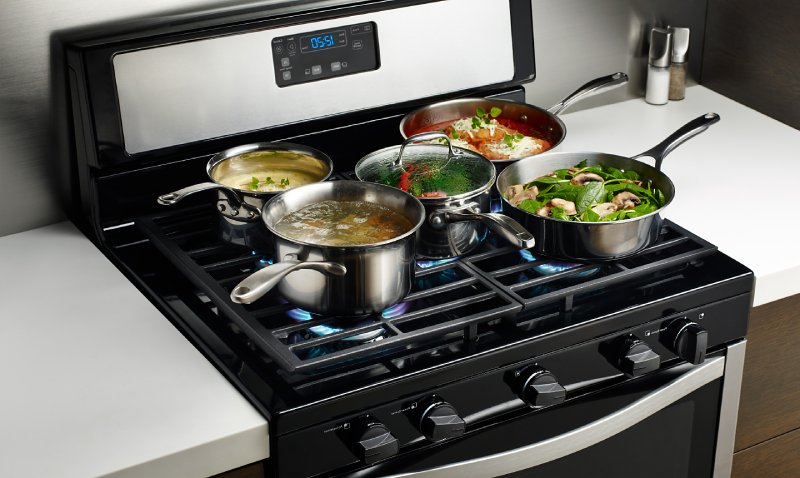When you are looking for the What is the best type of cookware to use on a gas stove? There is a lot to consider. Not all cookware was designed to be equal! Choosing the right cookware can help you create delicious meals that you and your family will enjoy.
This blog post discusses different types of cookware available, how they work with gas stoves, and what features are essential when selecting the type best suited for your cooking needs.
Whether you’re an experienced home cook or just starting in the kitchen, this information will give you clear insight into choosing the perfect piece for an enjoyable meal prep experience.
Material Matters: Exploring Cookware Materials
Stainless Steel
Advantages and disadvantages: This classic cookware material is the go-to choice for professional chefs and home cooks. Its durability, heat distribution, and corrosion resistance make it an excellent option for gas stoves. However, stainless steel cookware can be heavy and require more frequent cleaning than other materials.
Best suited for certain types of cooking: Stainless steel is the classic choice for gas stoves due to its excellent heat distribution properties. It’s a great option for searing, sautéing, and simmering.
Cast Iron
Advantages and disadvantages: Cast iron is revered for its ability to evenly distribute and retain heat, making it ideal for low-temperature cooking. But be aware that cast iron cookware can weigh a lot, rust easily, and may require more care, like seasoning with oil or wax to prevent oxidation.
Pre-seasoning and maintenance: Pre-seasoning is coating cast iron with oil to protect it from oxidation. If you cook acidic or coconut oil-rich recipes, you must reseason them more often.
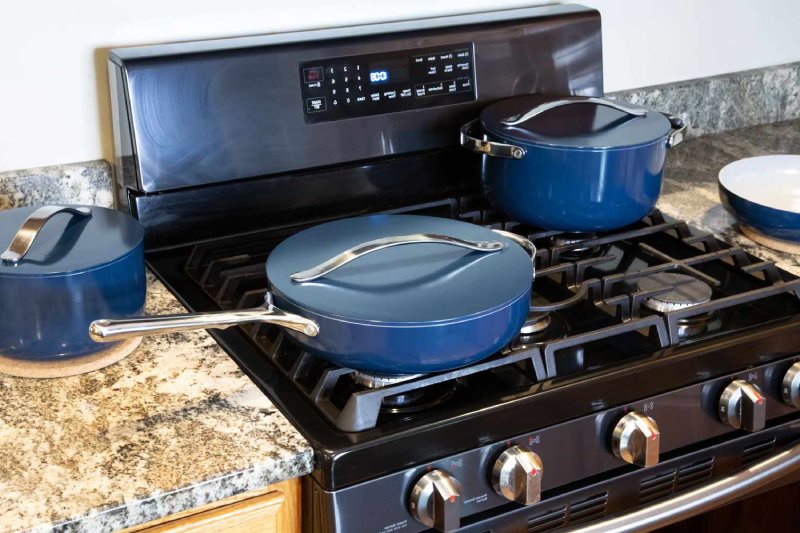
Copper
Advantages and disadvantages: Copper is an excellent conductor of heat and is typically quite durable. However, copper cookware requires regular maintenance, or it will quickly oxidize and develop a patina.
How it interacts with heat: Due to its excellent thermal conductivity, copper is a great choice for an even and consistent heat distribution on the cooking surface.
Aluminum
Advantages and disadvantages: Aluminum is a lightweight and strong metal that heats quickly and evenly, making it an ideal choice for cookware. It is also very affordable. However, aluminum tends to discolor easily and reacts with acidic foods such as tomatoes and citrus.
Coated vs. uncoated: Uncoated aluminum is usually the most affordable, but if you’re looking for something that won’t discolor or react with acidic foods, look for cookware coated with anodized aluminum or some other non-reactive coating.
Non-Stick
Advantages and disadvantages: Non-stick cookware is an excellent choice for gas stoves as it offers easy food release, requires little to no grease or oil, and can provide even heating. However, they are not the most durable, and their non-stick properties tend to wear down over time.
Types of non-stick materials: Teflon and ceramic are the two most common non-stick materials.
The Importance of Heat Distribution
Why heat distribution matters on a gas stove?
When cooking on a gas stove, it is vital to ensure that heat is distributed evenly throughout the pan. This can be achieved by selecting cookware that conducts heat well and distributes it evenly. If a pan does not adequately distribute heat, food will become overcooked on one side while remaining uncooked or raw on the other.
Which materials provide the best heat distribution?
The best materials for heat distribution on a gas stove are stainless steel, aluminum alloy, and copper. All three of these materials are good conductors of heat, meaning they evenly distribute the heat generated by the flame over the entire surface area of the pan.
This helps ensure that food is cooked evenly without burning or becoming overcooked in any spot. Additionally, these materials have non-stick surfaces, allowing foods to slide off them when cooking is complete. These qualities make them among the top choices for cookware on a gas stove.
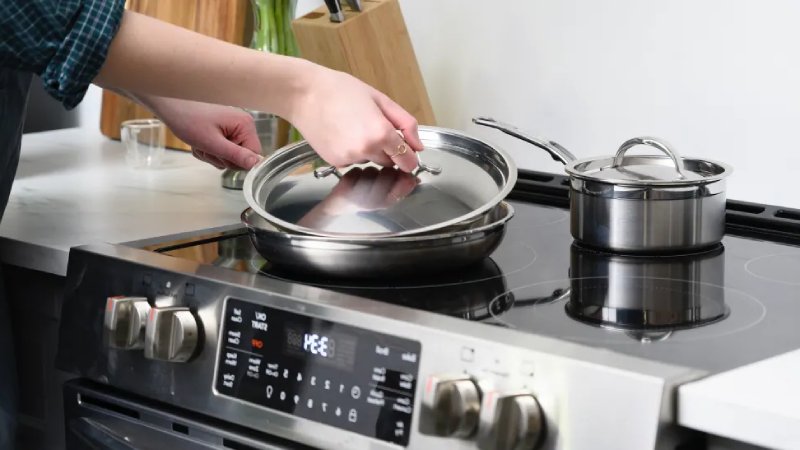
Cookware Thickness and Weight
How do thickness and weight affect cooking?
Thickness and weight are two critical factors when selecting cookware for a gas stove. Cookware that is too thin or light may not be able to evenly distribute the heat from the flame, resulting in uneven cooking. On the other hand, thicker and heavier pans tend to absorb and retain more heat, making them ideal for slow, steady cooking.
Additionally, thick cookware is less likely to warp or damage when exposed to high temperatures. For this reason, cast iron and stainless steel are often the best choices for gas ranges.
Optimal thickness and weight for gas stoves
The optimal thickness and weight of cookware on a gas stove depend mainly on the cooking type. For example, deep-frying or sautéing requires thicker and heavier pans than lighter fare such as scrambled eggs or pancakes.
Generally speaking, cast iron and stainless steel are excellent choices for most types of cooking on a gas stove, as they are thick and heavy enough to retain heat. However, non-stick cookware may be a better option for lighter fare due to its lightweight construction.
Compatibility with Gas Stove Grates
Types of gas stove grates
When selecting cookware for use on a gas stove, it is essential to consider the type of grate used on the appliance. The most common types are continuous grates and separate burner grates. Continuous grates span the cooking surface and evenly distribute heat across all burners.
Different burner grates have one central grate that divides each burner. The shape and size of cookware should also be considered, as this will affect how it sits on the grate. Round pans work best on continuous grates, while square or rectangular pans are preferred for separate burner grates.
Cookware that works well with different grate types
Non-stick cookware is typically recommended for gas stoves, as it is designed to be used at higher temperatures and will not damage the grate’s surface. Cast iron and aluminum are suitable materials but should be handled carefully to avoid scratching or denting the grates. Stainless steel cookware can be safely used on both grates as long as it is not too thick or heavy.
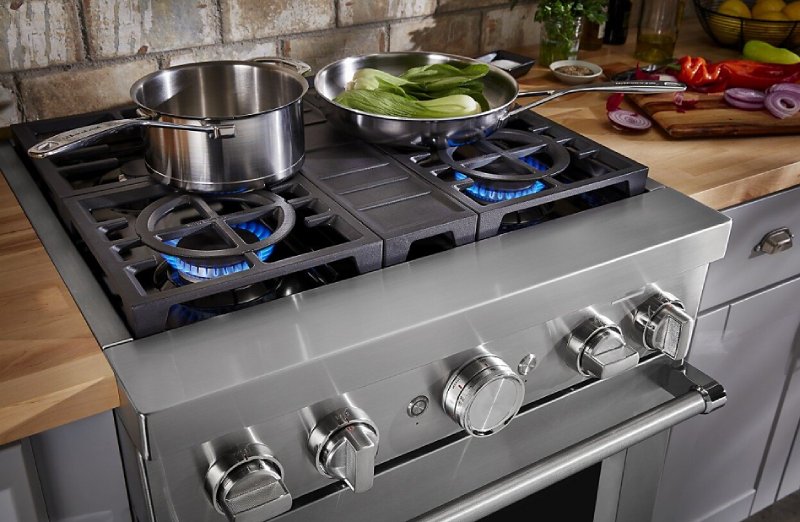
Handle and Lid Design
Importance of handle and lid design
For a stove, it is essential to consider your cookware’s handle and lid design. Lids too heavy or overly large may not fit on the burners correctly, resulting in uneven heating or even dangerous steam build-up. A handle should also be designed to stay cool during use so you can easily remove the pot from the stove without needing a heavy-duty kitchen mitt.
A good handle should be made of durable plastic or stainless steel and have an ergonomic, comfortable grip design. Additionally, look for cookware with lids designed so that steam can escape while cooking, ensuring even heat distribution and preventing boiling over when preparing foods such as pasta or boiling vegetables.
Features to look for in handles and lids
When selecting cookware, look for items with a secure lid and a ventilated design. This helps ensure proper air circulation and steam escape as your food cooks. Handles should be designed to stay calm so you can quickly move the pot around on the stovetop without burning your hands.
Finally, some lids are designed to be slightly more profound than the pots, allowing you to use them as extra-large sauté pans or woks. This can be useful when preparing larger batches of food, such as stir-fry dishes.
Safety Concerns
Cookware materials and potential health risks
Safety should be a top priority when selecting cookware for use on a gas stove. Many different materials can be used to make pots and pans, but not all are safe when exposed to high heat or acidic food. Choose cookware made from materials that are safe and non-toxic when heated.
Some common materials include stainless steel, cast iron, and anodized aluminum. These materials are generally considered safe to use on a gas stove. Additionally, they will be less likely to leach metals or other harmful chemicals into your food which can be a health concern.
Tips for safe use of cookware on gas stoves
Taking the necessary precautions when using cookware on a gas stove is essential. Pots and pans should be regularly cleaned and inspected for wear and tear, as any cracks or damage can lead to leakage of toxic substances when heated. Additionally, make sure the cookware is the correct size for your burner; large pots should not be used on small burners, as this could cause a fire.
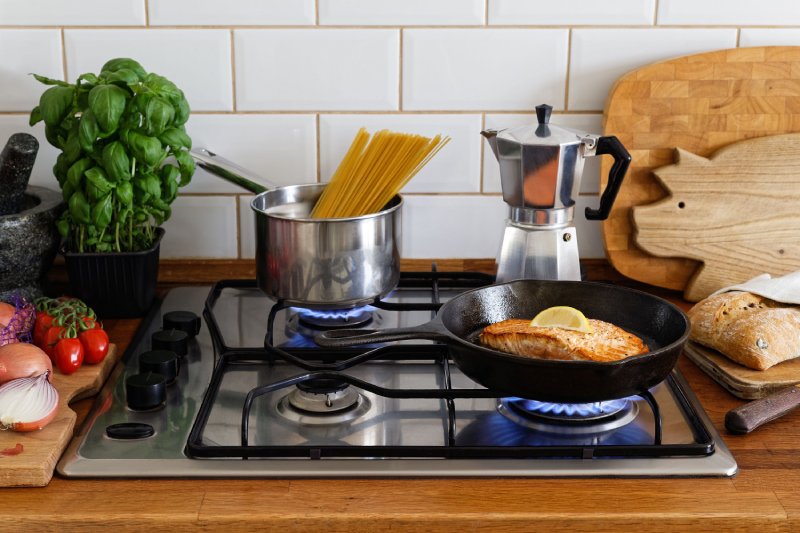
Budget and Longevity
Cost of various cookware materials
Depending on your budget, several types of cookware can be used on a gas stove. Stainless steel is an economical choice for those looking to save money. Cast iron has a higher initial cost but offers excellent longevity and heat distribution, making it ideal for long-term use.
Non-stick coatings also provide good value if you want a low-maintenance cooking surface. These materials can be used on gas stoves and give the desired performance. Ultimately, it comes down to personal preference and budget when selecting the best cookware for your kitchen.
Expected lifespan and durability of different materials
When choosing the best cookware for use on a gas stove, you should also consider the expected longevity of each material. Stainless steel is very durable and can last for years with proper care. Iron has an even longer lifespan and will retain its heat-disting qualities over time.
Non-stick coatings tend to wear out quickly but can be replaced relatively easily. Ultimately the choice of material is up to the consumer and should reflect their expectations for how long they plan on using the cookware.
Top Cookware Brands for Gas Stoves
Overview of popular cookware brands
When cooking on a gas stove, certain types of cookware work better than others. Stainless steel, cast iron, and enameled cast iron are popular options for gas stoves. Some of the best cookware brands that feature these materials include All-Clad, Le Creuset, Lodge, Calphalon, Cuisinart, and KitchenAid.
All-Clad is well known for its stainless steel cookware sets. Each heavy-duty piece features an aluminum core for even heat distribution during cooking. All-Clad parts have three layers: an interior layer made from 18/10 stainless steel, a core layer made from aluminum, and an exterior layer made from magnetic stainless steel. This combination creates a strong and durable cooking surface suitable for any type of stovetop, including gas stoves.
Le Creuset is another popular option for cooks investing in quality cookware. Their enameled cast iron pots and pans are renowned for their durability and heat retention capabilities. They also come in various colors and styles, so you can choose the one that best suits your kitchen needs. The enamel coating helps protect the pot or pan from wear and tear while also providing even heating across the entire surface when cooking on a gas stove.
Lodge is known for its cast iron skillets and Dutch ovens, ideal for gas stoves due to their superior heat retention capabilities. Cast iron requires more maintenance than other materials, but it can last many years when properly cared for.
Calphalon is a manufacturer of both stainless steel and non-stick cookware sets. The cookware pieces are designed to be lightweight while still providing even heat distribution during cooking. Calphalon also offers specialty items such as woks, steamers, and griddles that can also be used on gas stoves.
Cuisinart makes both stainless steel and ceramic cookware sets that are suitable for use on gas stoves. Their stainless steel pieces feature an aluminum core for even heating throughout the cooking process. Cuisinart’s ceramic cookware is made from a durable material resistant to scratches, chips, and stains.
KitchenAid also makes a wide variety of cookware suitable for gas stoves. Their stainless steel pieces feature a hard-anodized aluminum core for even heat distribution while cooking. KitchenAid’s non-stick pans are made from a triple-layer construction that helps prevent hotspots during cooking and makes them easy to clean after use.
When looking for cookware sets to use on a gas stove, it’s important to consider quality and performance. By selecting pieces from reputable brands like All-Clad, Le Creuset, Lodge, Calphalon, Cuisinart, or KitchenAid, you can be assured of higher quality cookware that will provide lasting performance for your kitchen.
Comparing the quality and features of top brands
When selecting the best cookware for use on a gas stove, it’s essential to compare the quality and features of different brands. All-Clad is known for its stainless steel construction that ensures even heat distribution during cooking, while Le Creuset provides enameled cast iron pots and pans with superior heat retention.
The lodge is famous for its cast iron skillets and Dutch ovens, which are ideal for use on gas stoves due to their durability. Calphalon offers lightweight stainless steel pieces with an aluminum core, while Cuisinart makes both stainless steel and ceramic cookware sets. Finally, KitchenAid has traditional non-stick cookware and specialty items such as woks and griddles that can be used on gas stoves.
Caring for Your Cookware
Proper cleaning and maintenance of different materials.
When cooking on a gas stove, the best cookware is made of stainless steel, cast iron, and aluminum. Each material provides specific benefits that make it well-suited for use with a gas stove.
Stainless steel is an excellent choice for cookware because it is resistant to corrosion and heat damage. It also has a long service life, meaning it can last many years with proper maintenance. To clean stainless steel cookware, rinse them in hot water and scrub it with a soft sponge or cloth before drying thoroughly.
Cast iron is another popular option because of its durability and ability to retain heat evenly across its surface. While cast iron does not rust like other metals would if exposed to moisture, it can discolor over time if not appropriately maintained. To keep your cast iron cookware looking new, avoid using abrasive materials to clean them and instead opt for a non-abrasive cleaner such as baking soda to scrub away any food residue.
Aluminum is a lightweight material that heats quickly and evenly, making it ideal for gas stoves. However, aluminum may be prone to corrosion or discoloration when exposed to acidic foods; therefore, it is essential to rinse off this type of cookware after each use and dry it immediately before storing it.
No matter what type of cookware you choose for your gas stovetop, proper maintenance, and care are crucial to preserving its condition. Clean all types of cookware with mild detergent and a soft cloth to avoid scratching or damaging the surface.
For more stubborn stains, use a non-abrasive cleaner like baking soda. Always dry your cookware thoroughly after washing them to prevent rust or discoloration. With regular cleaning and proper maintenance, you can be sure that your gas stovetop will last many years.
Tips to prolong the life of your cookware.
To ensure that your cookware lasts as long as possible, it is essential to take a few extra steps to protect them. Here are some tips for prolonging the life of your cookware:
- Always use trivets or pans in between hot cookware and table surfaces
- Avoid storing wet cookware for extended periods
- Do not use metal utensils on non-stick surfaces to prevent scratches
- Clean all types of cookware with gentle detergent and a soft cloth
- Use only warm water when cleaning stainless steel and aluminum pans
- To remove stubborn stains from cast iron, scrub with baking soda instead of abrasive materials
These simple tips can help keep your cookware in excellent condition for longer. With regular cleaning and maintenance, you can be sure that your gas stovetop will remain a reliable cooking surface for many years.
Conclusion: What is the best type of cookware on a gas stove?
There is no one-size-fits-all solution when deciding on the best type of cookware for a gas stove. Non-stick and cast iron are famous for their durability and heat retention qualities. However, depending on your preferences, stainless steel may also be a great option as it is more resilient than non-stick and easier to maintain than cast iron.
Ultimately, the correct type of cookware for you will depend on how much time you want to dedicate to its maintenance and whether or not you prefer non-stick surfaces. With the variety of cookware available today, you can find something that meets all your needs.
Read more:

